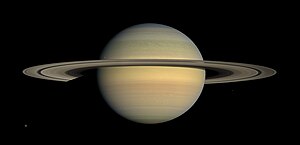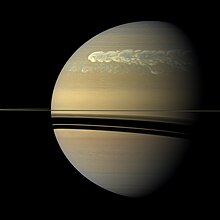Saturn theme by Paja
Download: Saturn.p3t

(1 background)
 | |||||||||||||
| Designations | |||||||||||||
|---|---|---|---|---|---|---|---|---|---|---|---|---|---|
| Pronunciation | /ˈsætərn/ [1] | ||||||||||||
Named after | Saturn | ||||||||||||
| Adjectives | Saturnian /səˈtɜːrniən/,[2] Cronian[3] / Kronian[4] /ˈkroʊniən/[5] | ||||||||||||
| Symbol | |||||||||||||
| Orbital characteristics[6] | |||||||||||||
| Epoch J2000.0 | |||||||||||||
| Aphelion | 1,514.50 million km (10.1238 AU) | ||||||||||||
| Perihelion | 1,352.55 million km (9.0412 AU) | ||||||||||||
| 1,433.53 million km (9.5826 AU) | |||||||||||||
| Eccentricity | 0.0565 | ||||||||||||
| |||||||||||||
| 378.09 days | |||||||||||||
Average orbital speed | 9.68 km/s (6.01 mi/s) | ||||||||||||
| 317.020°[8] | |||||||||||||
| Inclination | |||||||||||||
| 113.665° | |||||||||||||
| 2032-Nov-29[10] | |||||||||||||
| 339.392°[8] | |||||||||||||
| Known satellites | 146 with formal designations; innumerable additional moonlets.[11][12] | ||||||||||||
| Physical characteristics[6] | |||||||||||||
Mean radius | 58,232 km (36,184 mi)[b]
9.1402 Earths | ||||||||||||
Equatorial radius |
| ||||||||||||
Polar radius |
| ||||||||||||
| Flattening | 0.09796 | ||||||||||||
| Circumference | 365882.4 km (227348.8 mi) (equatorial)[13] | ||||||||||||
| Volume |
| ||||||||||||
| Mass |
| ||||||||||||
Mean density | 0.687 g/cm3 (0.0248 lb/cu in)[c] 0.1246 Earths | ||||||||||||
| 0.22[15] | |||||||||||||
| 35.5 km/s (22.1 mi/s)[b] | |||||||||||||
| 10 h 32 m 36 s; 10.5433 hours,[16] 10 h 39 m; 10.7 hours[7] | |||||||||||||
| 10h 33m 38s + 1m 52s − 1m 19s [17][18] | |||||||||||||
Equatorial rotation velocity | 9.87 km/s (6.13 mi/s; 35,500 km/h)[b] | ||||||||||||
| 26.73° (to orbit) | |||||||||||||
North pole right ascension | 40.589°; 2h 42m 21s | ||||||||||||
North pole declination | 83.537° | ||||||||||||
| Albedo | |||||||||||||
| |||||||||||||
| −0.55[23] to +1.17[23] | |||||||||||||
| −9.7[24] | |||||||||||||
| 14.5″ to 20.1″ (excludes rings) | |||||||||||||
| Atmosphere[6] | |||||||||||||
Surface pressure | 140 kPa[25] | ||||||||||||
| 59.5 km (37.0 mi) | |||||||||||||
| Composition by volume | |||||||||||||
Saturn is the sixth planet from the Sun and the second-largest in the Solar System, after Jupiter. It is a gas giant with an average radius of about nine-and-a-half times that of Earth.[26][27] It has only one-eighth the average density of Earth, but is over 95 times more massive.[28][29][30] Even though Saturn is nearly the size of Jupiter, Saturn has less than one-third of Jupiter's mass. Saturn orbits the Sun at a distance of 9.59 AU (1,434 million km) with an orbital period of 29.45 years.
Saturn's interior is thought to be composed of a rocky core, surrounded by a deep layer of metallic hydrogen, an intermediate layer of liquid hydrogen and liquid helium, and finally, a gaseous outer layer. Saturn has a pale yellow hue due to ammonia crystals in its upper atmosphere. An electrical current within the metallic hydrogen layer is thought to give rise to Saturn's planetary magnetic field, which is weaker than Earth's, but which has a magnetic moment 580 times that of Earth due to Saturn's larger size. Saturn's magnetic field strength is around one-twentieth of Jupiter's.[31] The outer atmosphere is generally bland and lacking in contrast, although long-lived features can appear. Wind speeds on Saturn can reach 1,800 kilometres per hour (1,100 miles per hour).
The planet has a bright and extensive ring system composed mainly of ice particles, with a smaller amount of rocky debris and dust. At least 146 moons[32] are known to orbit the planet, of which 63 are officially named; this does not include the hundreds of moonlets in its rings. Titan, Saturn's largest moon and the second largest in the Solar System, is larger (while less massive) than the planet Mercury and is the only moon in the Solar System to have a substantial atmosphere.[33]
Name and symbol[edit]
Saturn is named after the Roman god of wealth and agriculture and father of Jupiter. Its astronomical symbol (![]() ) has been traced back to the Greek Oxyrhynchus Papyri, where it can be seen to be a Greek kappa-rho ligature with a horizontal stroke, as an abbreviation for Κρονος (Cronus), the Greek name for the planet (
) has been traced back to the Greek Oxyrhynchus Papyri, where it can be seen to be a Greek kappa-rho ligature with a horizontal stroke, as an abbreviation for Κρονος (Cronus), the Greek name for the planet (![]() ).[34] It later came to look like a lower-case Greek eta, with the cross added at the top in the 16th century to Christianize this pagan symbol.
).[34] It later came to look like a lower-case Greek eta, with the cross added at the top in the 16th century to Christianize this pagan symbol.
The Romans named the seventh day of the week Saturday, Sāturni diēs ("Saturn's Day"), for the planet Saturn.[35]
Physical characteristics[edit]
Saturn is a gas giant composed predominantly of hydrogen and helium. It lacks a definite surface, though it is likely to have a solid core.[36] Saturn's rotation causes it to have the shape of an oblate spheroid; that is, it is flattened at the poles and bulges at its equator. Its equatorial radius is more than 10% larger than its polar radius: 60,268 km versus 54,364 km (37,449 mi versus 33,780 mi).[6] Jupiter, Uranus, and Neptune, the other giant planets in the Solar System, are also oblate but to a lesser extent. The combination of the bulge and rotation rate means that the effective surface gravity along the equator, 8.96 m/s2, is 74% of what it is at the poles and is lower than the surface gravity of Earth. However, the equatorial escape velocity of nearly 36 km/s is much higher than that of Earth.[37]
Saturn is the only planet of the Solar System that is less dense than water—about 30% less.[38] Although Saturn's core is considerably denser than water, the average specific density of the planet is 0.69 g/cm3 due to the atmosphere. Jupiter has 318 times Earth's mass,[39] and Saturn is 95 times Earth's mass.[6] Together, Jupiter and Saturn hold 92% of the total planetary mass in the Solar System.[40]
Internal structure[edit]

Despite consisting mostly of hydrogen and helium, most of Saturn's mass is not in the gas phase, because hydrogen becomes a non-ideal liquid when the density is above 0.01 g/cm3, which is reached at a radius containing 99.9% of Saturn's mass. The temperature, pressure, and density inside Saturn all rise steadily toward the core, which causes hydrogen to be a metal in the deeper layers.[40]
Standard planetary models suggest that the interior of Saturn is similar to that of Jupiter, having a small rocky core surrounded by hydrogen and helium, with trace amounts of various volatiles.[41] Analysis of the distortion shows that Saturn is substantially more centrally condensed than Jupiter and therefore contains a significantly larger amount of material denser than hydrogen near its centre. Saturn's central regions contain about 50% hydrogen by mass, while Jupiter's contain approximately 67% hydrogen.[42]
This core is similar in composition to Earth, but is more dense. The examination of Saturn's gravitational moment, in combination with physical models of the interior, has allowed constraints to be placed on the mass of Saturn's core. In 2004, scientists estimated that the core must be 9–22 times the mass of Earth,[43][44] which corresponds to a diameter of about 25,000 km (16,000 mi).[45] However, measurements of Saturn's rings suggest a much more diffuse core with a mass equal to about 17 Earths and a radius equal to around 60% of Saturn's entire radius.[46] This is surrounded by a thicker liquid metallic hydrogen layer, followed by a liquid layer of helium-saturated molecular hydrogen that gradually transitions to a gas with increasing altitude. The outermost layer spans about 1,000 km (620 mi) and consists of gas.[47][48][49]
Saturn has a hot interior, reaching 11,700 °C (21,100 °F) at its core, and radiates 2.5 times more energy into space than it receives from the Sun. Jupiter's thermal energy is generated by the Kelvin–Helmholtz mechanism of slow gravitational compression, but such a process alone may not be sufficient to explain heat production for Saturn, because it is less massive. An alternative or additional mechanism may be the generation of heat through the "raining out" of droplets of helium deep in Saturn's interior. As the droplets descend through the lower-density hydrogen, the process releases heat by friction and leaves Saturn's outer layers depleted of helium.[50][51] These descending droplets may have accumulated into a helium shell surrounding the core.[41] Rainfalls of diamonds have been suggested to occur within Saturn, as well as in Jupiter[52] and ice giants Uranus and Neptune.[53]
Atmosphere[edit]
The outer atmosphere of Saturn contains 96.3% molecular hydrogen and 3.25% helium by volume.[54] The proportion of helium is significantly deficient compared to the abundance of this element in the Sun.[41] The quantity of elements heavier than helium (metallicity) is not known precisely, but the proportions are assumed to match the primordial abundances from the formation of the Solar System. The total mass of these heavier elements is estimated to be 19–31 times the mass of Earth, with a significant fraction located in Saturn's core region.[55]
Trace amounts of ammonia, acetylene, ethane, propane, phosphine, and methane have been detected in Saturn's atmosphere.[56][57][58] The upper clouds are composed of ammonia crystals, while the lower level clouds appear to consist of either ammonium hydrosulfide (NH4SH) or water.[59] Ultraviolet radiation from the Sun causes methane photolysis in the upper atmosphere, leading to a series of hydrocarbon chemical reactions with the resulting products being carried downward by eddies and diffusion. This photochemical cycle is modulated by Saturn's annual seasonal cycle.[58] Cassini observed a series of cloud features found in northern latitudes, nicknamed the "String of Pearls". These features are cloud clearings that reside in deeper cloud layers.[60]
Cloud layers[edit]

Saturn's atmosphere exhibits a banded pattern similar to Jupiter's, but Saturn's bands are much fainter and are much wider near the equator. The nomenclature used to describe these bands is the same as on Jupiter. Saturn's finer cloud patterns were not observed until the flybys of the Voyager spacecraft during the 1980s. Since then, Earth-based telescopy has improved to the point where regular observations can be made.[61]
The composition of the clouds varies with depth and increasing pressure. In the upper cloud layers, with temperatures in the range of 100–160 K and pressures extending between 0.5–2 bar, the clouds consist of ammonia ice. Water ice clouds begin at a level where the pressure is about 2.5 bar and extend down to 9.5 bar, where temperatures range from 185 to 270 K. Intermixed in this layer is a band of ammonium hydrosulfide ice, lying in the pressure range 3–6 bar with temperatures of 190–235 K. Finally, the lower layers, where pressures are between 10 and 20 bar and temperatures are 270–330 K, contains a region of water droplets with ammonia in aqueous solution.[62]
Saturn's usually bland atmosphere occasionally exhibits long-lived ovals and other features common on Jupiter. In 1990, the Hubble Space Telescope imaged an enormous white cloud near Saturn's equator that was not present during the Voyager encounters, and in 1994 another smaller storm was observed. The 1990 storm was an example of a Great White Spot, a short-lived phenomenon that occurs once every Saturnian year, roughly every 30 Earth years, around the time of the northern hemisphere's summer solstice.[63] Previous Great White Spots were observed in 1876, 1903, 1933, and 1960, with the 1933 storm being the best observed.[64] The latest giant storm was observed in 2010. In 2015, researchers used Very Large Array telescope to study Saturnian atmosphere, and reported that they found "long-lasting signatures of all mid-latitude giant storms, a mixture of equatorial storms up to hundreds of years old, and potentially an unreported older storm at 70°N".[65]
The winds on Saturn are the second fastest among the Solar System's planets, after Neptune's. Voyager data indicate peak easterly winds of 500 m/s (1,800 km/h).
